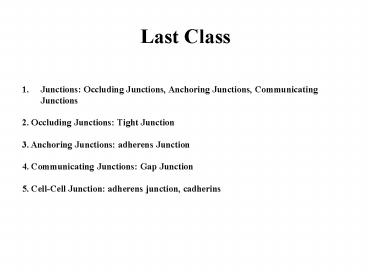Last Class - PowerPoint PPT Presentation
1 / 65
Title: Last Class
1
- Last Class
- Junctions Occluding Junctions, Anchoring
Junctions, Communicating Junctions - 2. Occluding Junctions Tight Junction
- 3. Anchoring Junctions adherens Junction
- 4. Communicating Junctions Gap Junction
- 5. Cell-Cell Junction adherens junction,
cadherins
2
- Manipulating DNA, RNA and Proteins
- Isolation of cells and cell culture
- DNA manipulation
- Protein measurement and analysis
3
- Isolating Cell and Cell Culture
- Tissue are disassembled by (1) preteolytic
enzymes to separate cells from ECM, e.g. trypsin
and collagenase, (2) together with reagents to
chelate Ca2. - 1. Centrifuge to separate based on size.
- 2. adhesion strength
- 3. Antibody binding
- A. FACS (fluorescence activated cell sorter).
- B. Microdissection (Laser capture
microdissection)
4
FACS Machine Fluorescence cells labeled with
negative charges, Non-fluorescence cells with
positive charges, Clustered cells no charges due
to their large sizes
5
Laser capture microdissection A laser beam to
excise a region of interest and select for
further culture
6
In vitro Cell Cultures Some terminologies in
vitro, in vivo, primary culture
Phase contrast images of fibroblasts (A) and
myoblasts (B)
7
In vitro Cell Cultures
Phase contrast images of oligodentrocytes (C) and
tobacco cells (BY2 immortal cell line) (D)
8
(No Transcript)
9
Hybrid Cells
10
Preparation of Hybridomas that secrete desired
monoclonal antibodies
11
(No Transcript)
12
Cell Fraction
- Centrifuge
- Chromatography
- Polyacrylamide Gel Electrophoresis
- Mass Spectrometry
13
The preparative Ultracentrifuge
14
Cell Fraction by Centrifuge
15
Further separation Velocity sedimentation (size
and shape) and equilibrium sedimentation (buoyant
density)
16
The separation of molecules by column
chromatography
17
Three Typical Chromatography Methods
18
Three Typical Chromatography Methods Affinity
Chromatography usually gives better specificity
19
Protein purification with the combination of
chromatography approaches
20
(No Transcript)
21
SDS and b-mercaptoethanol for Electrophoresis
22
SDS PAGE I
23
SDS PAGE II
24
SDS PAGE III
25
Western Blot
26
Western Blot
27
Separation of protein molecules by isoelectric
focusing
28
2D PAGE Coomassie blue stainging
29
2D Western Blot Tobacco cells, (A) gel staining
(B) phospho-thereonine
30
A peptide map or fingerprint of a protein
31
Mass Spectrometry Matrix-assisted laser
desorption ionization-time-of-flight spectrometry
(MALDI-TOF)
32
Genetic Engineering
33
Key Techniques
- Restriction nucleases
- DNA replication by vector or polymerase chain
reaction - Accurate Nucleic acid hybridization
- Gene sequencing
- Monitoring Gene expression
34
Gel Electrophoresis to separate DNAs with
different sizes
35
Labeling DNA in vitro (I)
36
Labeling DNA in vitro (II)
37
DNA hybridization
38
Nucleic acid hybridization for the determination
of specific DNA fragment
39
Northern and Southern Blots RNA and DNA Detection
40
Northern and Southern Blots
41
Microarray
42
DNA sequencing (I)
43
DNA sequencing (II)
44
DNA sequencing (III)
45
DNA sequencing (IV)
46
DNA sequencing (V)
47
Polymerase Chain Reaction (PCR) (I)
48
Polymerase Chain Reaction (PCR) (II)
49
Polymerase Chain Reaction (PCR) (III) Movie
50
PCR Applications Amplification of a gene of
interest for cloning
51
PCR Applications Forensic Science
52
Restriction nucleases
53
Rejoining DNA after restriction digestion
54
DNA Cloning
55
DNA cloning and amplification
56
Protein Production by DNA Cloning
57
Analyzing Protein Functions With DNA Cloning Tools
58
Localization or Amplification of proteins by DNA
Cloning of fusion proteins
59
Detection of protein interactions by DNA Cloning
of fusion proteins (I)
60
Detection of protein interactions by DNA Cloning
of fusion proteins (II)
61
Detection of protein interactions by DNA Cloning
of fusion proteins (III) Yeast two-hybrid system
62
Identify Tumor Biomarkers by DNA Cloning Phage
display
63
Gene Mutation
64
Gene Mutation
Digestion and Destroy
65
Summary
- Isolating Cells
- Cell Fraction
- Genetic Engineering
- Protein analysis with DNA cloning tools































